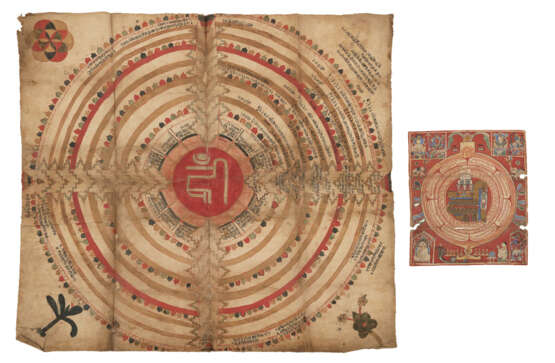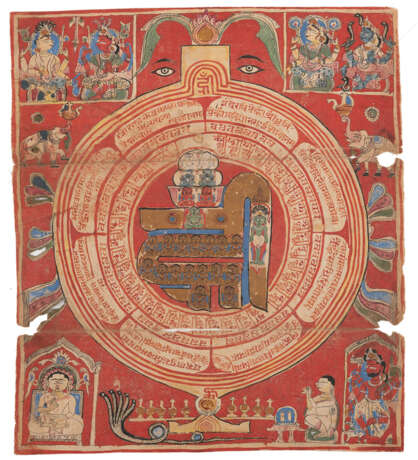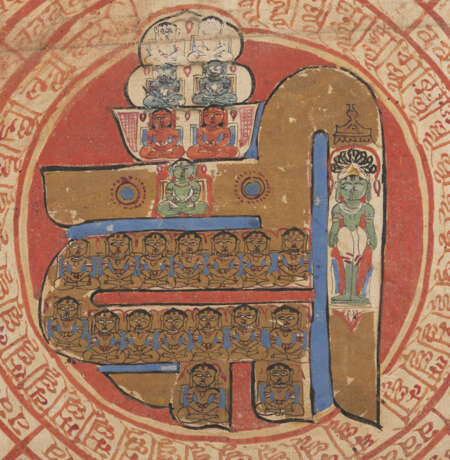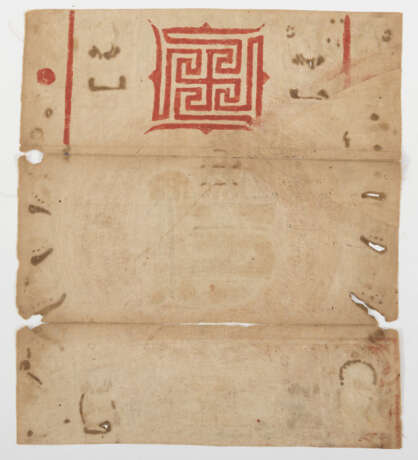ID 972882
Lot 1841 | Zwei jainistische Yantra
Estimate value
€ 1 200 – 1 800
24,5 x 28 und 75 x 68
I: Das kreisförmige Yantra in Form einer achtblättrigen, stilisierten Blüte zeigt in der Mitte die durch goldenen Farbauftrag hervorgehobene heilige Silbe hṛīṃ. Darauf angeordnet sind die vierundzwanzig Jinas jeweils mit unterschiedlicher Körperfarbe. Auf der rechten Seite der Ligatur ist der Jina Pārśva mit Schlangenhaube und als einziger stehend platziert. Im Ganzen betrachtet ist das Yantra als stilisierte Vase mit verkleinertem Fuß, seitlich angebrachten Zierschlaufen und zwei rankenartigen Blättern mit dazwischenliegender Blüte gestaltet. Die Augen zu beiden Seiten der Tülle sind ein Stilmittel, das vor allem von den Malschulen in Rajasthan verwendet wurde. In den oberen Ecken sitzen zwei Götterpaare, die aufgrund der Schlangenhaube bzw. Schlangen als Attribut und Begleiter den mythischen, halbgöttlichen Schlangenwesen (Sanskrit: nāga) zugeordnet werden können. Eine fünfköpfige Schlange flankiert am unteren Bildrand die Verehrungszeremonie eines jainistischen Mönches, der vor einem kleinen Altar mit Fußabdrücken eines Heiligen kniet. Ein weiterer Mönch ist in der linken unteren Ecke in einem Schrein platziert. Die Malweise vor rotem Hintergrund mit blauen Farbeinschüben (sog. „sekundärer Hintergrund“) verweist auf die westindischen Malschulen Gujarats und Rajasthans. Auch die Gestaltung der abgebildeten Figuren folgt der dort gängigen Konvention und ähnelt den bekannten Miniaturmalereien der Buchkunst, die dort vor allem im 15. und 16. Jahrhundert in großer Zahl hergestellt wurden. II: Das kreisförmige Diagramm ist stilisierte Darstellung einer Versammlungshalle (Sanskrit: samavasaraṇa, wörtlich: „Versammlung“ oder „Zusammenkunft“; eine Aufschrift im Randbereich nennt entsprechend saṃosaraṇa) die der jainistischen Überlieferung zufolge von den Göttern errichtet wurde, um dem Jina nach der Erlangung der Allwissenheit einen angemessenen Ort für seine erste Predigt zu bieten. Die Draufsicht zeigt die mit Zinnen versehenen, konzentrischen Mauern um einen erhöhten Sockel in der Mitte des Bauwerks, von dem aus der Jina in die vier Himmelsrichtungen predigt. Der Sitzplatz des Jina ist durch eine rote Farbfläche markiert, darauf ist mit goldener Tinte die heilige Silbe hṛīṃ angebracht. Die kreisförmigen Mauern teilen das Bauwerk in mehrere Bereiche, in denen sich die Götter, Menschen und Tiere versammeln, um der Lehre des Jina zu lauschen. Der Zugang erfolgt durch schematisch angedeutete Portale, die auf allen vier Seiten durch das Gebäude bis in dessen Zentrum verlaufen. Die Abbildung der heiligen Silbe hṛīṃ anstelle des predigenden Jina folgt einer Überlieferung, wonach dessen Predigt nicht durch Worte, sondern durch die Verbreitung eines göttlichen Klanges (Sanskrit: divyadhvani) stattfand. In dem Klang manifestiert sich demzufolge die gesamte Lehre der Jinas, weshalb divyadhvani den Gläubigen als Quelle der jainistischen Überlieferung gilt.
| Address of auction |
Nagel Auktionen GmbH Neckarstrasse 189 - 191 70190 Stuttgart Germany | ||||||||||||||
|---|---|---|---|---|---|---|---|---|---|---|---|---|---|---|---|
| Preview |
| ||||||||||||||
| Phone | +49 (0)711 649 690 | ||||||||||||||
| Fax | +49 (0)711 649 69696 | ||||||||||||||
| Buyer Premium | 29,5% | ||||||||||||||
| Conditions of purchase | Conditions of purchase | ||||||||||||||
| Business hours | Business hours
|









